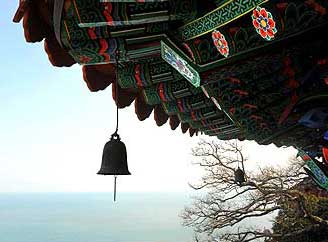
|
|
|
Home Asia Pacific North Asia S/N Korea Arts & Culture Wooden fish gongs and wind chimes: Symbols of Buddhist cultivationBy Chun Ock-bae, The Korea Times, July 8, 2010Seoul, South Korea -- Anyone interested in the temple decorations of Korean temples will discover painted and sculpted fish all around the main halls _ on the pillars, brackets, ceiling and walls. It is also easy to find wooden fish gongs and wind chimes.
A long time ago, there was a monk who committed many unwholesome deeds. Eventually, he died and was reborn as a fish with a tree on its back. One day when the monk's old master was crossing the river, the fish came to him sadly. The master looked into its past life and held a memorial ceremony to save the fish. That night, the fish appeared in the master's dream, appreciative of his master's kindness. He asked his master to please cut the tree from his back and make a fish-shaped instrument and tell this story as a lesson for practitioners.
As the wind chime clappers, fish- shaped gongs (``moktak'') are symbols to inspire constant diligence and alertness. Moktak is a hollow, wooden percussion instrument used to mark the rhythm of chanting. It is shaped like the wooden fish but is smaller and round and used in Buddhist ceremonies when reciting sutras and chanting. It is the most representative among the ceremonial instruments used by Buddhist priests. To make a moktak, they carve wood into a large bell, cut it in half and hollow it out and glue it back together. Then, it is played by hitting it with a wooden stick. Originally it used to be made bearing the likeness to fish. Moktak is a small version of ``mogeo'' (wooden fish), one of the four Buddhist instruments.
It is also a necessity in conducting ``doryangseok" (the daily predawn chanting service) in which a monk or nun walks around the temple, also waking up the other practitioners. In the ritual of ``beompae'' ( Buddhist music), it is played keeping in tune with the music. Historically, people made both fish-shaped and circular moktak, but after successive generations the circular design prevailed. Fish are not restricted to the grounds of temples; they also are suspended in the air. Fish wind chimes are found on the eaves of Buddhist halls and pagodas. The wind rings the chimes, awakening the monks and nuns. Practitioners, like the fish who are always aware in the sea, practice to continuously cultivate themselves, even in their dreams. The wind in the chimes is likened to the condition of complete freedom from obstruction. The fish adorning temples is not only a metaphysical symbol of tranquility and unrestricted freedom; it also a character in Buddhist fables. An example of this can be found in the Jatakas, the stories of the Buddha's previous lives as follows: In one of his former lives, Sakyamuni Buddha followed bodhisattva practices while dwelling in the sea. There he witnessed a large fish preying on smaller ones, which in turn, did the same with still smaller ones. So Sakyamuni caught and ate the biggest fish, sparing the life of the small fish. This Sakyamuni's soul was transformed into the king of the ``makaras'' (a mythical animal with the trunk of an elephant, the front legs of a lion, and the body of a crocodile) with a massive body measuring several ``li'' (a distance of about 400 meters). At that time, famine had struck the land by the sea and people were turning to cannibalism. A huge makara, Sakyamuni beached himself on the shore and offered himself up as food, thereby saving the people from starvation. On a related note, traditional keys in Korea were usually shaped like fish. The primary purpose of a lock and key is to bar thieves from entry, and the fish is a cautionary sign for its owner to remain alert day and night. |
 |
|
| Korean Buddhist News from BTN (Korean Language) |
|
 |
|
|
Please help keep the Buddhist Channel going |
|
| Point
your feed reader to this location |
|

 The origin of the use of the fish in Buddhism is unknown: one version tells that a fish always has its eyes open day and night; thus it is a reminder to always be aware. Another version comes from a story:
The origin of the use of the fish in Buddhism is unknown: one version tells that a fish always has its eyes open day and night; thus it is a reminder to always be aware. Another version comes from a story: The best material for making moktak is the jujube tree, yet wood from birch, ginkgo, or zelkova is popularly used as well. There are two types of moktak: one is the large moktak, which is placed upon a small cushion and usually used in gathering the temple people; the other is a small handheld one used in chanting, services, and reciting the sutras inside the Dharma halls.
The best material for making moktak is the jujube tree, yet wood from birch, ginkgo, or zelkova is popularly used as well. There are two types of moktak: one is the large moktak, which is placed upon a small cushion and usually used in gathering the temple people; the other is a small handheld one used in chanting, services, and reciting the sutras inside the Dharma halls.

